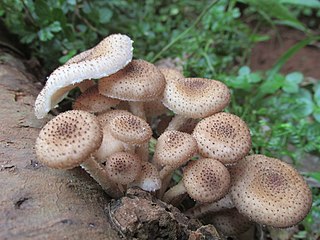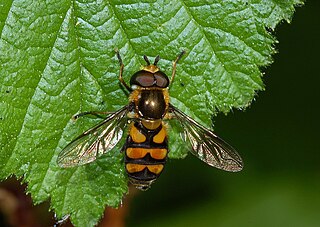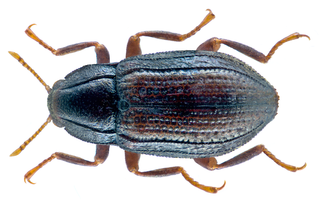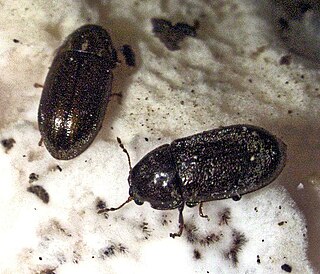
The bush rat or Australian bush rat is a small Australian nocturnal animal. It is an omnivore and one of the most common indigenous species of rat on the continent, found in many heathland areas of Victoria and New South Wales.

The minute black scavenger flies or "dung midges", are a family, Scatopsidae, of nematoceran flies. Despite being distributed throughout the world, they form a small family with only around 250 described species in 27 genera, although many await description and doubtless even more await discovery. These are generally small, sometimes minute, dark flies, generally similar to black flies (Simuliidae), but usually lacking the humped thorax characteristic of that family.

Armillaria fuscipes is a plant pathogen that causes Armillaria root rot on Pinus, coffee plants, tea and various hardwood trees. It is common in South Africa. The mycelium of the fungus is bioluminescent.

The dusky-footed woodrat is a species of nocturnal rodent in the family Cricetidae. They are commonly called "packrats" or "trade rats" and build large, domed dens that can reach several feet in height. Coyotes and other predators will attempt to prey on these rodents by laying waste to the dens, but the sheer volume of material is usually dissuasive. Occasionally, dusky-footed woodrats will build satellite dens in trees. Although these animals are solitary, except in the mating season, dens are frequently found in clusters of up to several dozen, forming rough "communities". The mating system in this species appears to be variable, with promiscuity most generally at high population densities and monogamy at lower densities.

The dusky-footed elephant shrew or dusky-footed sengi is a species of elephant shrew in the family Macroscelididae. It is found in Democratic Republic of the Congo, South Sudan, and Uganda. Its natural habitat is subtropical or tropical dry lowland grassland.

The big-eared woodrat is a nocturnal rodent of the woodrat genus Neotoma, in the family Cricetidae. Closely related to, and formerly included in the species Neotoma fuscipes, it is endemic to western North America and occurs west and south of the Salinas Valley from the California Coast Ranges south of Monterey Bay to northern Baja California, as well as in the Sierra Nevada, extending north to the South Fork American River.

Didea, the lucent flies is a holarctic genus of black and yellow large sized flies 10–15 mm (0.39–0.59 in). belonging to the hoverfly family of Diptera. The larvae feed on aboreal aphids.
Abacetus fuscipes is a species of ground beetle in the subfamily Pterostichinae. It was described by Johann Christoph Friedrich Klug in 1833.

Agapetus is a genus of little black caddisflies of the family Glossosomatidae. There are at least 210 described species in Agapetus.
Waldegrave Islands Conservation Park is a protected area located on the following islands within the Investigator Group in South Australia: the Waldegrave Island, Little Waldegrave Island and the Watchers.
Nerthra fuscipes is a species of toad bug in the family Gelastocoridae. It is found in the Caribbean, Central America, North America, and South America.
Cylindridia is a genus of flower weevils in the beetle family Curculionidae, with currently seven valid names included. The species occur from Canada to Argentina.
Aeoloplides fuscipes, the southern coast bush grasshopper, is a species of spur-throated grasshopper in the family Acrididae. It is found in North America.
Gynaikothrips is a genus of tube-tailed thrips in the family Phlaeothripidae. There are more than 30 described species in Gynaikothrips.

Oulimnius is a genus of riffle beetles in the family Elmidae. There are about 15 described species in Oulimnius.

Cis fuscipes, the minute tree-fungus beetle, is a species of minute tree-fungus beetle in the family Ciidae. It is found in Australia, the Caribbean, North America, Oceania, and Europe.
Pachybrachis fuscipes is a species of case-bearing leaf beetle in the family Chrysomelidae. It is found in North America.
Cordilura fuscipes is a species of dung fly in the family Scathophagidae.
Glossina fuscipes is a riverine fly species in the genus Glossina, which are commonly known as tsetse flies. Typically found in sub-Saharan Africa but with a small Arabian range, G. fuscipes is a regional vector of African trypanosomiasis, commonly known as sleeping sickness, that causes significant rates of morbidity and mortality among humans and livestock. Consequently, the species is among several being targeted by researchers for population control as a method for controlling the disease.

Trigonopterus fuscipes is a species of flightless weevil in the genus Trigonopterus from Indonesia.











